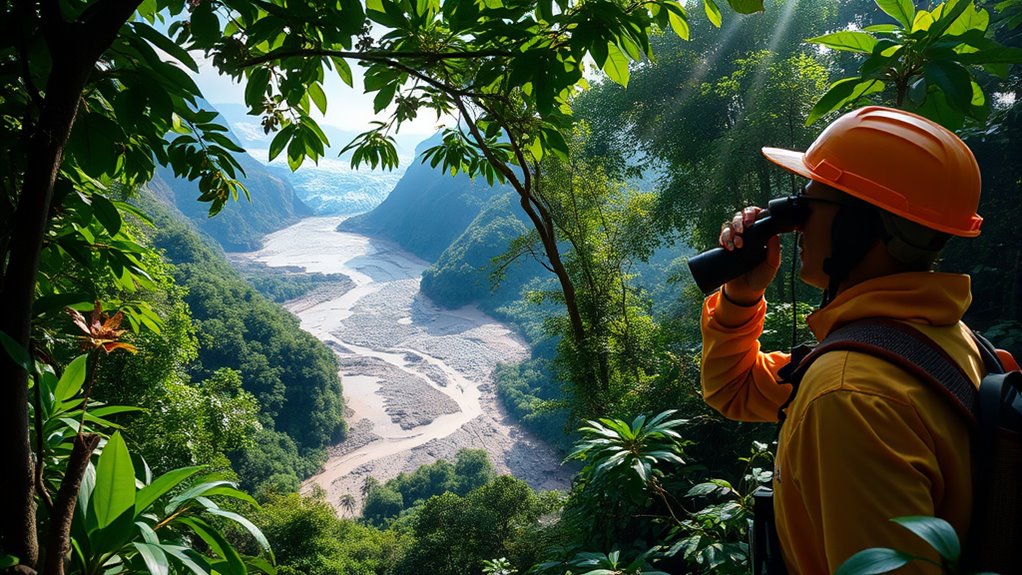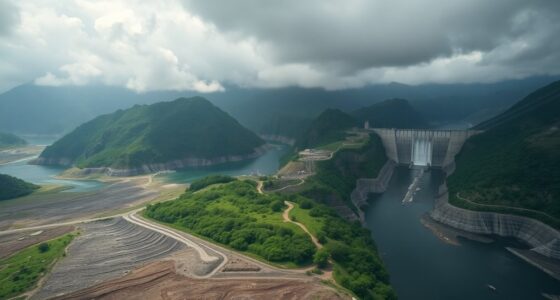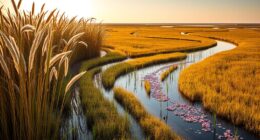Climate change is reshaping conservation strategies by pushing efforts beyond protected areas and emphasizing landscape connectivity through wildlife corridors, which help species migrate and maintain genetic diversity. Conservationists now focus on restoring habitats, removing barriers, and using technology like GPS tracking and remote sensing to monitor changes. Adaptive management, including species translocation and climate modeling, allows for quicker responses to environmental shifts. Keep exploring to understand how these innovative approaches are shaping a resilient future for ecosystems.
Key Takeaways
- Conservation efforts now prioritize landscape connectivity through wildlife corridors to facilitate species migration.
- Restoration of degraded habitats and removal of barriers enhance ecological resilience against climate impacts.
- Technology, like GPS tracking and remote sensing, is used for monitoring species movement and habitat changes.
- Management strategies are increasingly adaptive, incorporating climate modeling and rapid response techniques.
- Conservation plans focus on landscape-scale, dynamic solutions that anticipate future climate scenarios to protect biodiversity.

Climate change is accelerating environmental challenges, making conservation strategies more essential than ever. As global temperatures rise and weather patterns become more unpredictable, you’ll notice that many species are forced to migrate in search of suitable habitats. This phenomenon, known as species migration, is a natural response to changing conditions, but it’s happening at a pace that often outstrips the ability of ecosystems to adapt. When species move, they sometimes encounter habitat fragmentation—where human development, agriculture, and infrastructure divide natural landscapes into smaller, isolated patches. This fragmentation hampers migration pathways, making it harder for species to find new homes, access resources, or reproduce successfully. It’s a double-edged sword that threatens biodiversity and complicates conservation efforts.
Climate change accelerates habitat fragmentation, hindering species migration and threatening biodiversity.
In response, conservation strategies are evolving beyond traditional protected areas. You now need to consider landscape connectivity, creating wildlife corridors that allow species to navigate fragmented habitats safely. These corridors act as ecological bridges, enabling migration and gene flow between isolated populations, which is indispensable for their survival amid climate change. Restoring degraded habitats and removing barriers like roads or fences become priorities, as they help facilitate natural migration routes. You’ll also find that some conservationists are employing innovative technologies, such as GPS tracking and remote sensing, to monitor species movements and identify critical migration corridors. This data-driven approach helps in designing effective interventions that keep pace with the rapid environmental shifts caused by climate change.
Moreover, climate change calls for adaptive management plans. You need flexible strategies that can respond quickly to new migration patterns or unexpected habitat losses. This might include assisting species in migration through translocation or creating artificial habitats temporarily while natural ones recover. As species shift their ranges, conservation efforts also have to incorporate climate modeling to predict future migration trends and habitat needs. Understanding these patterns allows you to prioritize areas that will become indispensable habitats in the coming decades, ensuring long-term biodiversity resilience.
In essence, addressing species migration and habitat fragmentation requires a proactive, innovative approach to conservation. You must think beyond static protected areas and embrace dynamic, landscape-scale solutions. By integrating technology, restoring connectivity, and planning for future climate scenarios, you can help safeguard ecosystems against the disruptive effects of climate change. This shift in strategy is indispensable to maintain ecological balance, protect endangered species, and ensure that nature continues to thrive despite the rapid environmental changes happening around us.
Frequently Asked Questions
How Do Local Communities Participate in Climate-Adaptive Conservation?
You can participate in climate-adaptive conservation by engaging with your community and sharing local knowledge. Your involvement helps develop strategies that reflect indigenous insights and address specific environmental challenges. By collaborating with local groups, you support efforts to protect ecosystems and adapt to climate impacts. Your active participation guarantees that conservation efforts are culturally relevant and more effective, fostering resilience and sustainable practices rooted in community engagement.
What Funding Options Support Climate-Resilient Conservation Projects?
You can access innovative grants and leverage public-private partnerships to fund climate-resilient conservation projects. These options provide flexible financial support, encouraging collaboration between governments, businesses, and communities. By pursuing grants focused on climate adaptation, you increase your project’s sustainability. Public-private partnerships also offer shared resources and expertise, boosting your ability to implement effective conservation strategies that withstand climate impacts. These funding avenues are essential for building resilient ecosystems.
How Is Technology Used to Monitor Climate Impacts on Ecosystems?
While it’s often said that technology offers new eyes on our world, you’re really harnessing tools like satellite imaging and sensor networks to monitor climate impacts on ecosystems. These innovations provide real-time data, revealing subtle changes and helping you track shifts in biodiversity and habitat health. By actively using these technologies, you can make informed decisions, adapt strategies, and better protect ecosystems facing the complex challenges of a changing climate.
Are There Legal Frameworks Specifically Addressing Climate-Related Conservation Challenges?
You’ll find that legal frameworks are increasingly addressing climate-related conservation challenges through new reforms. These laws focus on strengthening policy enforcement, ensuring that environmental protections adapt to changing conditions. By implementing legal reforms, governments hold industries accountable and promote sustainable practices. You can actively support these efforts by staying informed about policy updates and advocating for stronger conservation laws that effectively tackle climate impacts, helping protect ecosystems for future generations.
How Do Conservation Strategies Vary Across Different Climate Zones?
Imagine a world where your actions ripple through diverse climates. Conservation strategies vary across zones by focusing on species migration and habitat connectivity. In tropical areas, efforts prioritize protecting rainforests, while in arid zones, water conservation becomes key. You adapt your methods to each climate’s unique challenges, ensuring that species can move and ecosystems remain connected, safeguarding biodiversity against climate change’s unpredictable tide.
Conclusion
As you’ve seen, climate change is truly turning the tide on conservation efforts. To stay ahead, you need to adapt your strategies and think outside the box. The key is to be proactive rather than reactive, because when the chips are down, those who act swiftly will have a better shot at protecting our planet’s precious ecosystems. Remember, it’s not just about weathering the storm, but about steering through it with purpose and resolve.








